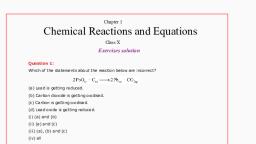Page 1 :
HD 4HD* 4648 51%, , Chemical Reactions, , ‘Chemical reaction is a process that involves rearrangement ofthe molecular or ionic structure of, a substance, as distinct from a change in physical form or a nuclear reaction., , The two basic types chemical reactions are, , 1. Endothermic, 2. Exothermic, , Endothermic Reaction:, , AA chemical reaction that is accompanied by the absorption of heat, or an organism that generates,, heat to maintain its temperature, , Example: Melting ice cubes. Melting sold salts. Evaporating liquid water, Exothermic Reaction:, , A chemical reaction in which energy releases inthe form of heat or light. It isthe opposite of an, endothermic reaction., , Example: Burning of natural gas, Catalysts:, , A substance which can alter the rate of the reaction without itself undergoing any chemical, change., , Catalysts can be positive (e.g, finely divided iron increases rate of formation of ammonia from, hydrogen and nitrogen) or negative (eg. phosphoric acid decreases the rate of decomposition of, hydrogen peroxide), Enzymes are biological catalysts in our body., , Chemical Reactions are further divided into:, , + Combination or Synthesis reactions: A combination or synthesis reaction is one, where, a new product is synthesised by a combination of two or three reactants, , (HY>xy), Examples;, , 2Pb +0, —2Pb0, H, +l, + 2HCI, , Decomposition reaction: Decomposition reaction is one, where one compound, decomposes or breaks into two or mote different products, , (WY x+y), , There are 3 types of decomposition:, , 1. Thermal decomposition (by heating)., Example: CaCO, — CaO + COz, 2, Electrolytic decomposition (by electric current), Example: 2Hy 0-212 +O», 3. Photochemical decomposition (in sunlight), Example, Single Displacement reaction, , ‘When a cation or an anion is exchanged from a compound, this is called as single displacement, reaction, , X4YZ 5 XZ+Y, Example, , Fe+ CuSO, —FeS0, + Cu., , Elements higher in eactive series displace elements that are in lower series., Double displacement reaction, , The anions are exchanged between two compounds or sats. Such reactions result in a different, combination of cations and anions, atthe end,, XY +AZ—XZ+AY, , Example, Precipitate formation: Pb (NO, )z +2KI—>2KNO; + Pbly (yellow lead iodide precipitate), Oxidation and Reduction:, , Oxidation: Addition of Oxygen atom, removal of a Hydrogen atom or loss of electrons., Examples, , AFe +30, +H; 0 2Fe, Oy Hs O (rust), , 2Cu+0, +2Cv0, , Reduction: Addition of hydrogen atom, removal of oxygen, the gain of electrons., , Examples, , CuO +H, Cu+H, 0
















































